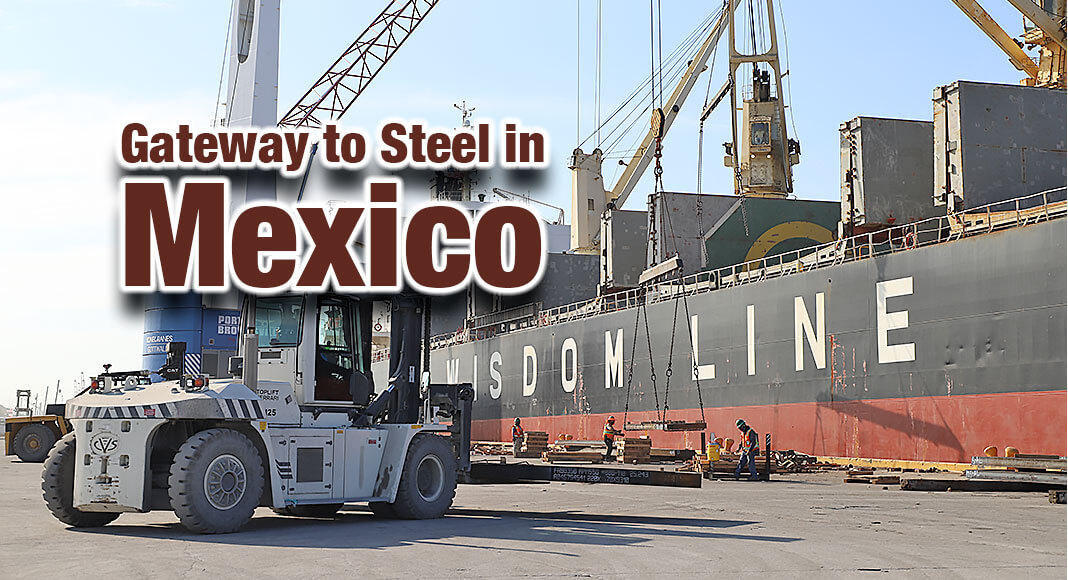
Texas Border Business
BROWNSVILLE, Texas – Steel is a large and significant mainstay in Brownsville, where the port is the major gateway for steel into Mexico, moving more than three million short tons of steel commodities per year.
The Port of Brownsville is the closest deep-water port to Mexico’s industrial center in Monterrey – more than 100 miles closer than the nearest Mexican port, saving shippers time and money with direct access to many area factories.
Under construction is a major terminal development at the port to maximize the efficient loading of open-top gondola railcars for steel slab shipments to feed Ternium’s recently expanded mill in Pesqueria, Nuevo Leon, Mexico. With an expected increase of steel throughput, the Port of Brownsville is planning to spend millions to accommodate greater volumes and expedite the movement of steel through the port.
The port is also a major transshipment center for liquid products like premium gasoline, diesel, jet fuels and lubricants, before being transported to final destinations across Mexico. Previously, customers in Mexico had to purchase energy through Pemex – but now, they can acquire commodities on the market through their own resources. As a result, demand for refined products continues to steadily grow and the port’s capabilities to manage large volumes gives customers the reach into the interior of Mexico – a significant advantage in the competitive market.
For example, Sunoco LP, one of the largest independent fuel distributors in the United States, announced in May 2021 the development of a refined products terminal at the Port of Brownsville. The greenfield terminal, with 560,000 barrels of storage, will provide supply flexibility to the company’s existing fuel distribution business in South Texas. The site will also facilitate Sunoco’s efforts to sell into the growing fuels export market to Mexico. Sunoco expects the terminal to be in service by the second quarter of 2022 with a total investment of approximately $55 million of which approximately $40 million will be invested in 2021.
In the most recent report to the Foreign Trade Zones Board, FTZ No. 62 recorded a record-setting $8.9 billion for the combined value of imports and exports moving through the zone in 2019. The total value of export shipments through FTZ No. 62 reached $4.3 billion in 2019; $4.6 billion in imports. These numbers, the highest recorded in the zone’s history, saw products in the petroleum industry and shipbuilding equipment, supported by the steady transport of steel, aluminum and wind energy components. The Port’s strategic location on the U.S./Mexico border makes FTZ No. 62 an attractive place for shippers and cargo owners, which supports further job growth in the community.
Ranking among the top U.S. steel ports, the Port of Brownsville moves more steel into Mexico than any other domestic competitor. In 2020, the port moved more than 3 million short tons of steel across the southern border.
That comes as no surprise with more than 10 million eager consumers within a three-hour drive of the port – with many of those located south of the border. Moving cargo across the border in both directions is made easy with a wide variety of reliable transportation options.
Providing Class 1 rail service to and from the port to Mexico and all of North America includes Kansas City Southern de México for operations south of the border, and with Union Pacific and BNSF Railway serving northern routes. On-port rail service is provided by agreement with OmniTRAX, operating the Brownsville Rio Grande International Railway (BRG) on more than 45 miles of port-owned railroad.
When trucks are a better option, the Port of Brownsville claims conceptual ownership of the state’s first overweight corridor. Trucks crossing the border in either direction utilizing the specially designated route to or from the port, can load to the legal weight limits of Mexico – 125,000 pounds (45,000 pounds heavier than domestic limits). That translates into real savings in both time, money and logistical efficiencies.













